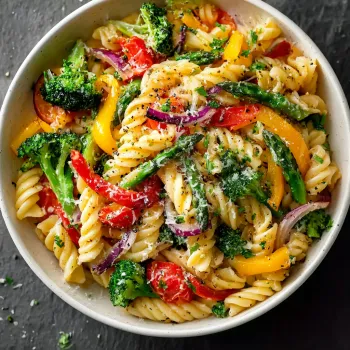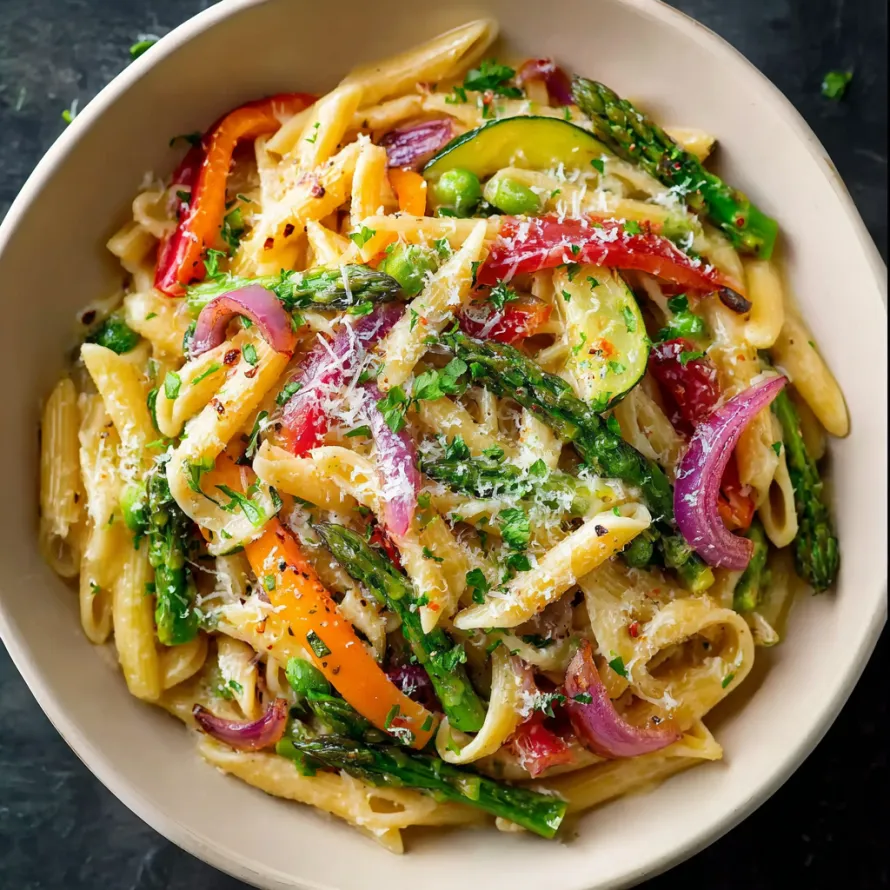 Pin it
Pin it
This colorful pasta primavera became my spring and summer go-to dinner after I needed something lighter but still satisfying for weeknight meals. The combination of fresh, seasonal vegetables and a simple lemon-olive oil sauce creates a dish that feels both wholesome and indulgent at the same time.
I first created this recipe when trying to use up a farmers market haul that was threatening to spoil. My family loved it so much that it now appears on our table at least twice a month, especially when the garden is producing more vegetables than we can keep up with.
Ingredients
- Broccoli florets: adds nutrition and a pleasant bite make sure they're cut into even pieces for consistent cooking
- Carrot: thinly sliced or julienned for sweetness and color choose firm bright orange carrots for best flavor
- Red bell pepper: adds vibrant color and sweet flavor look for glossy skin and firm texture
- Red onion: provides aromatic foundation and slight sharpness select firm onions with tight dry skins
- Zucchini: contributes tender texture and mild flavor pick small to medium ones for best taste
- Yellow squash: adds color variety and subtle sweetness similar to zucchini in texture
- Grape tomatoes: burst with juicy freshness when heated choose ripe ones that yield slightly to pressure
- Garlic minced: fresh provides essential aromatic depth use fresh rather than pre-minced for best flavor
- Fresh parsley: brings brightness and color to finish the dish Italian flat-leaf variety offers more flavor than curly
- Dried penne pasta: holds the sauce well in its ridges and tube a good quality brand makes a difference
- Dried Italian herbs: provides backbone of flavor without effort look for blends with oregano basil and thyme
- Salt: enhances all the flavors diamond crystal kosher salt is my preference for even distribution
- Extra virgin olive oil: forms the base of the sauce use a good quality one with fruity notes
- Fresh lemon juice: adds brightness and acidity Meyer lemons work beautifully if you can find them
- Grated Parmesan cheese: adds savory depth and richness splurge on Parmigiano Reggiano if possible
Step-by-Step Instructions
- Prepare The Vegetables:
- Wash all vegetables thoroughly and pat dry with paper towels. Cut broccoli into small florets about 1 inch in size. Slice carrots into thin rounds or julienne strips. Dice red bell pepper into half-inch pieces after removing seeds and membranes. Slice red onion into thin half-moons. Cut zucchini and yellow squash into quarter-inch half-moons. Halve grape tomatoes. Mince garlic finely. Chop parsley finely and set aside for garnish.
- Cook The Pasta:
- Bring a large pot of water to a rolling boil and add a generous amount of salt until it tastes like sea water. Add the penne pasta and cook according to package directions until al dente usually 9-11 minutes. Before draining reserve one cup of the starchy pasta water for the sauce. Drain pasta but do not rinse as the starch helps the sauce adhere.
- Sauté The Vegetables:
- While the pasta cooks heat three tablespoons of olive oil in a large skillet over medium-high heat. Add red onion and cook for 2-3 minutes until beginning to soften. Add garlic and cook for 30 seconds until fragrant being careful not to burn it. Add carrots and broccoli first as they take longer to cook stir for about 3 minutes. Add bell pepper zucchini and yellow squash and continue cooking for 3-4 minutes until vegetables are tender-crisp. Season with dried Italian herbs salt and pepper.
- Create The Sauce:
- Lower heat to medium-low and add halved grape tomatoes cooking just until they begin to soften about 1 minute. Squeeze fresh lemon juice over the vegetables and add 1/4 cup of the reserved pasta water creating a light sauce that will coat the pasta. If the mixture seems dry add more pasta water a little at a time.
- Combine And Serve:
- Add the drained pasta directly to the skillet with vegetables and toss gently to combine ensuring everything is evenly distributed. If needed add a splash more olive oil or pasta water to keep everything moist. Remove from heat and stir in half the chopped parsley and half the Parmesan cheese. Serve immediately in shallow bowls topped with remaining parsley and Parmesan.
 Pin it
Pin it
You Must Know
Pasta primavera means spring pasta in Italian reflecting its fresh vegetable-forward composition
This dish contains at least five servings of vegetables in one meal making it nutritionally balanced
The recipe is adaptable to any season just use whatever produce is at its peak
The very first time I made this dish I accidentally scorched the garlic which taught me an important lesson about adding it at just the right time. Now that perfectly toasted but not burnt garlic has become my signature touch to this recipe. My daughter always knows when this pasta is on the menu from the wonderful aroma that fills our kitchen.
Seasonal Adaptations
Pasta primavera truly shines when made with the freshest seasonal vegetables. In spring try asparagus tips peas and tender young spinach. Summer calls for corn kernels cherry tomatoes and garden-fresh herbs. Fall versions work beautifully with butternut squash roasted mushrooms and sage. Winter adaptations might include kale Brussels sprouts and root vegetables. The technique remains the same just adjust cooking times for harder or softer vegetables.
Make-Ahead Options
While pasta primavera is best enjoyed fresh you can prep components ahead of time to streamline weeknight cooking. Wash and chop all vegetables up to two days in advance storing them in airtight containers in the refrigerator. The pasta can be cooked one day ahead drained and tossed with a little olive oil then refrigerated. When ready to serve simply reheat the pasta briefly in hot water while cooking the vegetables then proceed with the recipe.
Serving Suggestions
This vibrant pasta works as a complete meal on its own but pairs beautifully with simple protein additions for a heartier dinner. Try adding grilled chicken slices sautéed shrimp or white beans for extra protein. A simple green salad with lemon vinaigrette and crusty artisan bread makes the meal complete. For wine pairing choose a crisp white like Pinot Grigio or Sauvignon Blanc that wont overpower the delicate vegetable flavors.
Frequently Asked Questions
- → What vegetables work best for Pasta Primavera?
Common choices include broccoli, carrots, red bell peppers, zucchini, yellow squash, and grape tomatoes. You can also use any seasonal veggies you have on hand.
- → Can I use a different pasta type?
Yes! Rotini, fusilli, or farfalle are great substitutes for penne.
- → What herbs should I use?
Dried Italian herbs work well, but fresh parsley or basil adds a great finishing touch. Customize with your favorite herbs.
- → How can I make it dairy-free?
Skip the Parmesan cheese or use a dairy-free alternative like nutritional yeast for a similar savory flavor.
- → Can I prepare this dish in advance?
Yes, but it's best enjoyed fresh. If making ahead, store the pasta and sauce separately to keep it from absorbing too much liquid.
